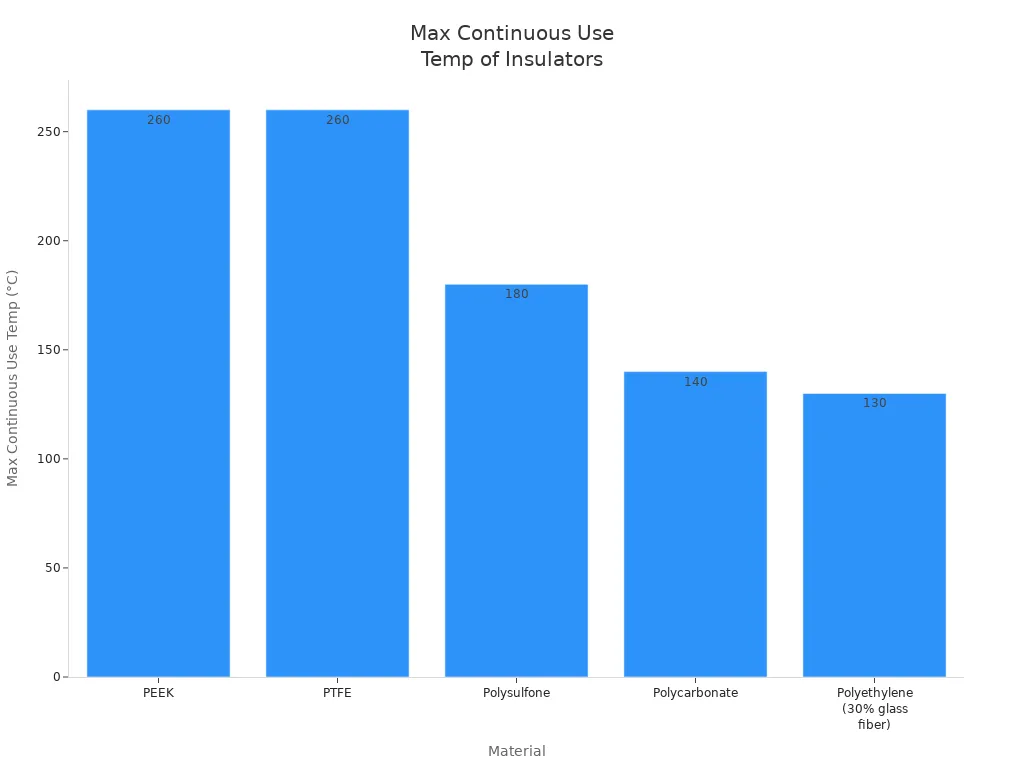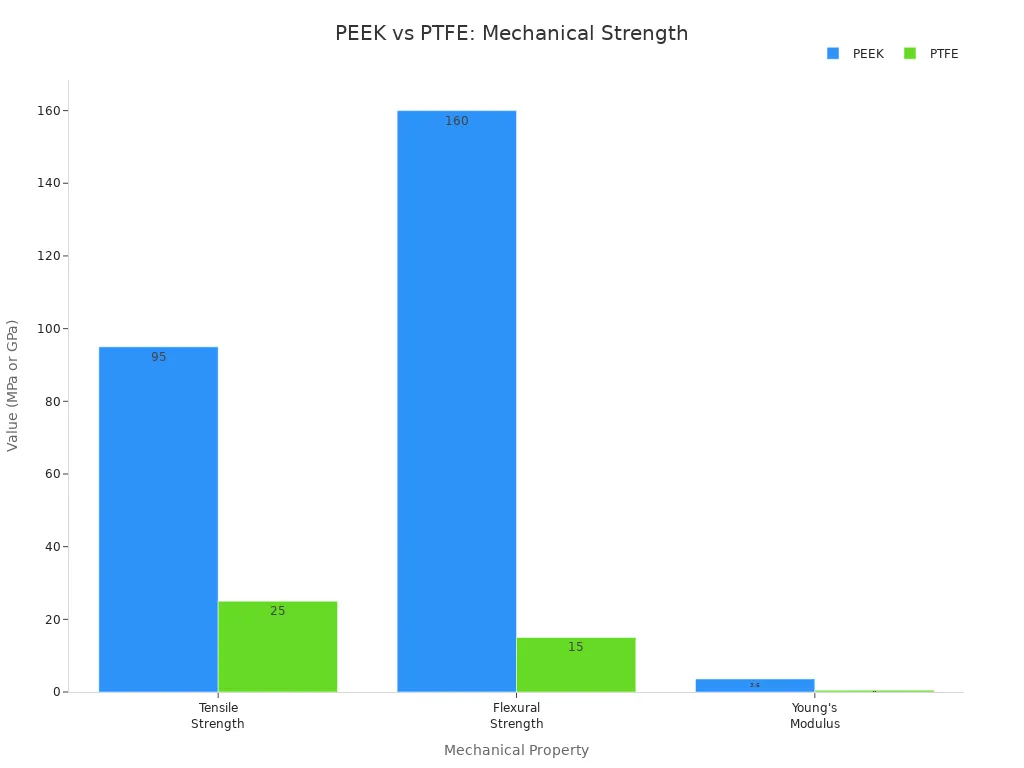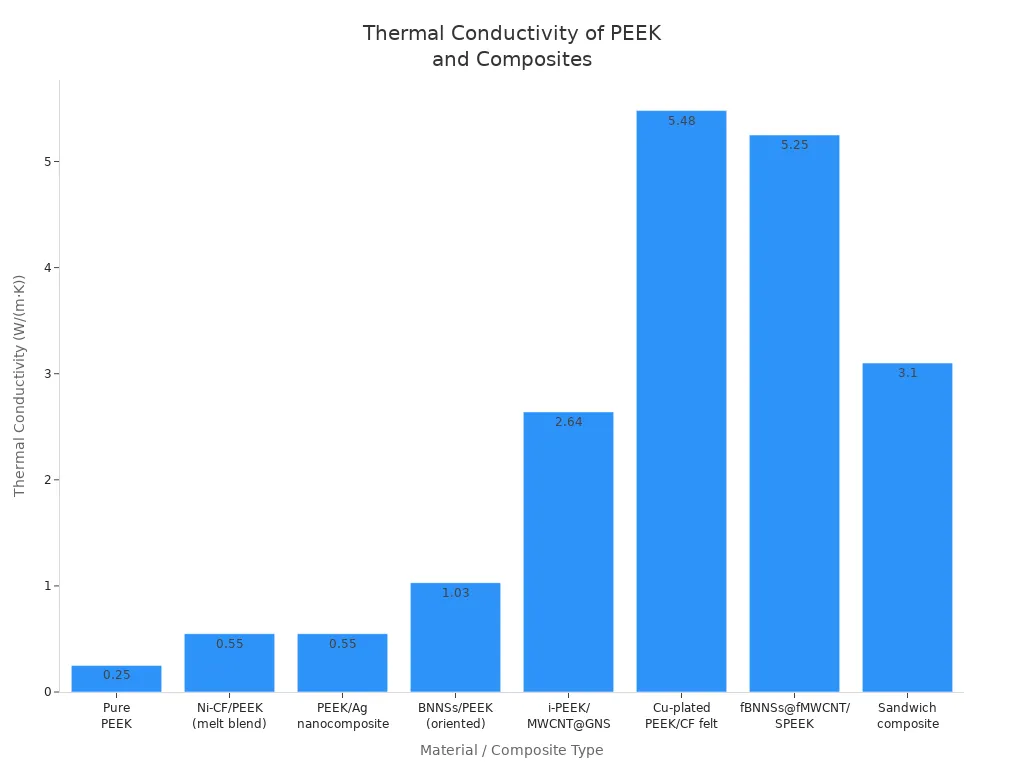Jul.
17, 2025
Contents
Why Choose PEEK for High-Performance Insulating Components
High-Performance Insulating Components
 PEEK is a top choice for high-performance insulating components. Engineers appreciate that it is as strong as metal but much lighter, allowing them to create innovative designs and improve fuel efficiency. PEEK resists damage from chemicals and water, making it ideal for demanding environments like oil rigs. It effectively blocks heat and electricity, even under extreme conditions. Manufacturers value its ability to withstand high temperatures and its long-lasting durability. Additionally, PEEK can be easily shaped using methods like CNC machining or injection molding.
PEEK is a top choice for high-performance insulating components. Engineers appreciate that it is as strong as metal but much lighter, allowing them to create innovative designs and improve fuel efficiency. PEEK resists damage from chemicals and water, making it ideal for demanding environments like oil rigs. It effectively blocks heat and electricity, even under extreme conditions. Manufacturers value its ability to withstand high temperatures and its long-lasting durability. Additionally, PEEK can be easily shaped using methods like CNC machining or injection molding.
PEEK gives great electrical insulation. This makes it a good pick for high-voltage and high-frequency places. Its dielectric strength is 480 V/mil. This is less than Ultem®, but better than many other plastics.
| Polymer | Dielectric Strength (V/mil) |
|---|---|
| Ultem® | 830 |
| PEEK | 480 |
PEEK keeps its insulation even in tough conditions. Its volume resistivity is about 10^16 Ω·cm. Its dielectric constant stays steady from 3.2 to 3.5 at many frequencies. It also has a low dielectric loss tangent at high frequencies. These things help PEEK block electric currents well. It works even with high voltage, pressure, or humidity. Its crystal structure and high thermal stability make it work better as an insulator in hard jobs.
PEEK can handle very high temperatures. It can be used up to 260°C. This is the same as PTFE and better than most plastics.
| Material | Maximum Continuous Use Temperature (°C) |
|---|---|
| PEEK | 260 |
| PTFE | 260 |
| Polysulfone | 180 |
| Polycarbonate | 140 |
| Polyethylene (30% glass fiber) | 130 |

PEEK melts at about 334°C. It stays stiff and strong up to this point. Its special structure with rings and linkages stops it from breaking down in heat. It keeps its shape well and does not change size much when hot. This stops it from warping or bending. PEEK also does not catch fire easily and makes little toxic smoke. This makes it good for planes, cars, and medical tools.
Tip: PEEK’s thermal stability lets it go through many steam cleanings without breaking down. This is important for medical and food uses.
PEEK stands up to many chemicals like acids and solvents. It also works well in wet and steamy places. This makes it good for tough factories where strong chemicals are used.
| Material | Chemical Resistance Characteristics |
|---|---|
| PEEK | Resistant to most chemicals, acids, and solvents; highly resistant to hydrolysis (hot water and steam) |
| PTFE | Excellent chemical resistance; almost completely inert to most chemicals |
| PPS | Good chemical resistance but lower than PEEK and PTFE; can be affected by some strong acids |
| Nylon | Resistant to oils and some chemicals; can be affected by strong acids and solvents |
PEEK resists chemicals better than PPS and Nylon. PTFE is still the best for chemical safety. PEEK can handle acids, solvents, and hot water without breaking down. This helps it last a long time in tough places.
PEEK is strong and stiff but not heavy. This makes it great for things that need to be tough and light. Its tensile strength is 100 to 170 MPa. Its Young’s modulus is between 3 and 4 GPa. These numbers are like some metals, such as aluminum, and much higher than most plastics.
| Polymer | Tensile Modulus (GPa) | Tensile Strength (MPa) | Temperature Effect on Modulus |
|---|---|---|---|
| PEEK | ~3 to 4 | 100 to 170 | Drops from ~3 GPa at 150°C to <1 GPa at 200°C |
| PPS | ~4 | Comparable to PEEK | Significant reduction at elevated temperatures |
| PAI | ~4 | High | Maintains higher modulus at 200°C |
| PBI | N/A | N/A | Maintains high modulus at 200°C |
| PI | N/A | N/A | Maintains high modulus at 200°C |
PEEK’s high modulus and strength stop it from bending under weight. It does not slowly change shape when pressed for a long time. Injection molding can make parts with exact sizes. This means parts stay the right size even with heavy use.
PEEK is strong and stiff, like aluminum.
It does not slowly change shape, so it stays the same size.
Its special chemical structure keeps it stable in tough places.
PEEK’s great strength and lightness make it a top pick for high-performance insulating parts. These parts need to handle stress, shaking, and hits.
PEEK and PTFE are both high-performance insulators. They have different strengths. PEEK is known for its strong build and stiffness. It also handles heat very well. PTFE is best for electrical insulation and chemical resistance. PEEK keeps its shape and strength under heat and heavy loads. PTFE can bend or change shape when it gets hot or is pressed.
| Mechanical Property | PEEK (Approximate) | PTFE (Approximate) |
|---|---|---|
| Tensile Strength | 90 - 100 MPa | 20 - 30 MPa |
| Flexural Strength | 150 - 170 MPa | 10 - 20 MPa |
| Young's Modulus | 3.6 GPa | 0.5 GPa |
PEEK is about five times stronger than PTFE. It can handle hits and does not change shape easily. This makes it good for parts that carry weight. PTFE is not as strong, so it is not used for tough jobs. But PTFE is still the best for electrical insulation.

Note: PEEK costs more than PTFE. It is more expensive because it is harder to make and many people want it. But PEEK lasts longer and works better in important jobs, so the price is often worth it.
PEEK and polyimide both work well with heat and chemicals. Polyimide can take even higher heat, up to 400°C. PEEK works up to 250°C. Polyimide also stands up to strong chemicals. But it is harder to make and costs more money. Over time, PEEK keeps its strength and insulation better than polyimide. Polyimide can get weaker and lose its good qualities after being in heat and wet air for a long time.
| Property / Metric | PEEK (After Aging) | Polyimide (PI) (After Aging) |
|---|---|---|
| Tensile Strength | Increased due to crosslinking | Decreased by 54% (severe degradation) |
| AC Breakdown Strength | Slight increase (1.6%) | Decreased |
PEEK is easier to make, costs less, and lasts longer. This makes it a good choice for most insulation needs.
Ceramics can take high heat and do not wear out fast. But they break easily if hit or bent. PEEK can handle heat like ceramics and keeps its size well up to 260°C. PEEK does not crack or break when dropped or hit. It is lighter than ceramics and can be made into many shapes.
| Material | Advantages | Disadvantages |
|---|---|---|
| PEEK | High strength, lightweight, tough, resists thermal shock | Lower stiffness, needs surface treatment for bonding |
| Ceramics | High temperature resistance, wear resistant | Brittle, heavy, prone to fracture |
PEEK is tough and bends without breaking. This makes it safer and more useful for high-performance insulating parts in hard places.
PEEK is very important in electronics. It helps keep electric parts safe. PEEK Lay-Flat™ tubing lines slots and insulates phases in motors. Magnet wires with PEEK insulation work well in tough places. They do not wear out or get hurt by chemicals. PEEKshrink™ heat shrink tubing covers wire joins and harnesses. Convoluted tubing protects wires and fiber optics from heat. These uses are found in cars, oil and gas, planes, and phone systems.
| Application Type | Description | Industry Examples |
|---|---|---|
| Electric Motor Insulation | PEEK Lay-Flat™ tubing used as slot liners and phase insulation in electric motors. | Automotive, SAGD |
| PEEK Insulated Wire | Magnet wire with PEEK insulation for harsh environments. | Oil & Gas, Automotive, Aerospace, Electrical |
| PEEKshrink™ Heat Shrink | Heat shrink tubing for wire splicing and harness protection. | Automotive, Aerospace, Telecommunications |
| Convoluted Tubing | Flexible conduit tubing for wires and fiber optics, withstanding up to 260°C. | Aerospace, Automotive, Industrial |
| Wire Harness Protection | PEEK convoluted tubing bundles and protects wires, reducing weight. | Automotive, Aerospace |
PEEK is a top pick for electronics. It blocks electricity, stands up to heat, and does not get damaged by chemicals.
Aerospace engineers use PEEK because it works well in hard places. PEEK stays strong and keeps its shape when it gets hot. This is important for planes that face big temperature changes. PEEK does not get ruined by chemicals, water, fuel, or steam. This helps parts last longer and need less fixing. PEEK does not burn easily and makes little smoke. This keeps people safer inside planes. PEEK is light, so planes can be up to 60% lighter than if made with metal. This saves fuel. PEEK also keeps heat and electricity from moving through parts better than metal.
PEEK is used in actuators, controls, and engine parts. Big companies trust PEEK for insulation that lasts a long time.
Car designers pick PEEK for high-voltage insulation and light parts.
| Benefit Category | Description | Impact on Automotive Insulating Components |
|---|---|---|
| Electrical Insulation | High dielectric strength prevents arcing and thermal runaway. | Enhances safety under extreme conditions. |
| Thermal Stability & Management | Superior thermal stability improves heat dissipation. | Maintains optimal temperatures and reliability. |
| Chemical Resistance | Excellent resistance to aggressive chemicals. | Prolongs lifespan and insulation quality. |
| Lightweight Nature | Lighter than metals, reducing vehicle weight. | Improves fuel efficiency and range. |
PEEK is tough and easy to shape. It makes car parts that are light and last a long time. These parts work better than old materials.
People who make medical devices like PEEK for many reasons. PEEK is safe for the body and can be used in implants and tools. Doctors can see through PEEK on X-rays, CT, and MRI scans. PEEK does not get hurt by chemicals, blood, or enzymes. It can be cleaned many times at high heat. PEEK is strong and bends like bone. This makes it good for bone devices.
These things make PEEK great for implants, reusable tools, and insulation for medical electronics.
PEEK is a top pick for high-performance insulating components. It has special qualities that help it work where other plastics and metals cannot. Engineers like PEEK because it is very strong. Parts made from it do not bend or break easily. They keep their shape even under a lot of stress. PEEK can handle heat up to 260°C for thousands of hours. This means it does not warp or lose its insulating power in tough places.
PEEK also stands up to chemicals and radiation. It does not get ruined by oils, acids, or strong radiation. This makes it great for planes, electronics, and medical tools. It does not soak up much water and keeps its size steady. This helps it insulate well, even when it is wet or humid.
The table below shows why PEEK is so good for high-performance insulating components:
| Property Category | Key Properties and Values |
|---|---|
| Thermal Stability | Withstands continuous use up to 260°C; melting point ~341°C; maintains strength after 5000 hours at 260°C |
| Mechanical Strength | High tensile strength (≥90 MPa), high modulus of elasticity, hardness, shock and creep resistance |
| Chemical Resistance | Resistant to organic solvents, oils, weak acids, alkalis without discoloration or degradation |
| Wear Resistance | Superior sliding and wear resistance compared to conventional plastics (e.g., POM, Nylon) |
| Dimensional Stability | Excellent, ideal for precision parts; resists deformation under load over time |
| Radiation Resistance | Highest among thermoplastics; resists embrittlement and cracking under high-dose gamma radiation |
| Electrical Insulation | Low dielectric constant (3.2-3.3 at 1 MHz), high dielectric strength (17-25 kV/mm), low dissipation factor (0.0015), excellent arc resistance (~190 s) |
| Moisture Absorption & Purity | Very low moisture absorption (0.03%), low outgassing, low metal ion contamination, suitable for vacuum/aerospace |
| Industry Compliance | Meets standards like NORSOK M-710C and ISO 23936-1, supporting use in demanding industrial environments |
PEEK is also great at blocking electricity. Its dielectric constant is about 3.2-3.3 at 1 MHz. It has a high dielectric strength of 17 to 25 kV/mm. It stops electricity from moving through it, even at high voltages and heat. Its special structure helps it insulate better.
In places with high voltage and heat, PEEK works better than many other materials. Pure PEEK does not move heat fast, but new PEEK composites can. These new types can spread heat better but still block electricity. This makes high-performance insulating components even more useful.

Tip: PEEK composites can spread heat well and still insulate electricity. This is perfect for tough electronic and industrial jobs.
Some engineers worry about the cost and supply of PEEK. It costs more than plastics like ABS or Nylon. But its great performance makes it worth the price for important jobs. PEEK is strong, handles heat, and resists chemicals. This means parts last longer and need less fixing. These things can make up for the higher price.
PEEK is easy to find for big projects. You can buy it as sheets, rods, or tubes in many sizes and types. There are glass-filled, bearing, FDA-safe, and special grades. You can order PEEK online with no minimum amount. Big orders get discounts. Companies can shape PEEK using CNC machines or other tools to make custom parts.
| Aspect | Details |
|---|---|
| Forms Available | Sheets, rods, tubes |
| Size Range | Sheets: 6"x6" to 24"x48"; Thickness: 0.25" to 4" |
| Rod Diameter: 0.187" to 6"; Tube Diameter: 30 mm to 210 mm | |
| Grades Available | Glass-filled, bearing grades, FDA compliant, metal and X-ray detectable, TECAPEEK®, SustaPEEK, Ketron® |
| Colors | Natural, black, dark blue |
| Purchasing Options | Online ordering with no minimum order requirements; volume discounts for large commercial orders |
| Fabrication Services | CNC routing, milling, vacuum forming, die cutting available |
| Application Examples | Aerospace, medical devices, semiconductor equipment, food processing machinery |
| Cost Comparison | More expensive than ABS, Polycarbonate, Nylon, Polypropylene but justified for high-performance uses |
| Performance Highlights | Superior mechanical, thermal, chemical resistance; suitable for demanding insulating components |
Some people think PEEK will not last as long as ceramics or metals in hard places. But PEEK does not crack or break down like some other materials. It keeps working well, even after lots of heat, chemicals, or radiation. This makes it a trusted choice for high-performance insulating components in planes, cars, electronics, and medical tools.
Note: PEEK comes in many forms and types. Its strong and lasting nature makes it a smart and dependable pick for high-performance insulating components.
PEEK is very strong and can handle heat and chemicals. Many engineers use it for important insulating parts. It is used in planes, electronics, and medical tools.
Planes like the Boeing 787 and Airbus A350 use PEEK. This helps make them lighter and safer.
Spacecraft and satellites use PEEK for insulation. It protects them from high heat and radiation.Experts say PEEK is best for jobs that must be safe and last a long time. Think about using PEEK in your next project for safety, good work, and long life.
PEEK is very strong and handles heat well. It does not get damaged by most chemicals. Engineers pick PEEK when other plastics do not work.
Tip: PEEK stays the same and works well, even in tough places.
Yes, PEEK is safe for people’s bodies. Medical device makers use it for implants and tools.
PEEK does not get hurt by chemicals or cleaning.
Doctors can see PEEK on X-rays and scans.
PEEK is easy to cut and shape with normal tools. Makers use CNC machines and molds to make exact parts.
PEEK stays steady, so parts can be made with close fits and tricky shapes.
PEEK keeps its strength and insulation for many years, even with heat and chemicals.
| Property | Performance |
|---|---|
| Heat Resistance | Up to 260°C |
| Chemical Stability | Excellent |
PEEK comes in many types, like glass-filled, bearing, and FDA-safe grades. You can buy sheets, rods, and tubes in many sizes.
Engineers can pick the best type of PEEK for each job.
Navigation
Navigation
Contact Us
Tel: +86 13417419143
E-mail: [email protected]
Add:
2nd Floor, Building 7, 156 High Tech Industrial Park, Fuyuan 1st Road, Zhancheng Community, Fuhai Street, Baoan District, Shenzhen City, China.